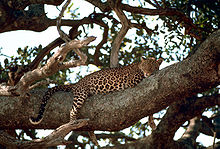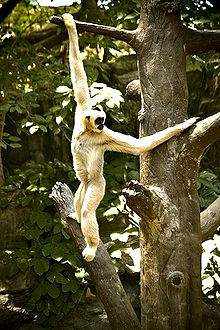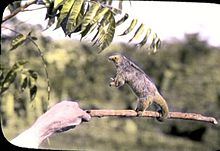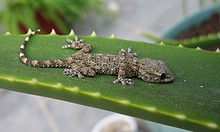- Arboreal locomotion
-
Arboreal locomotion is the locomotion of animals in trees. In every habitat in which trees are present, animals have evolved to move in them. Some animals may only scale trees occasionally, while others are exclusively arboreal. These habitats pose numerous mechanical challenges to animals moving through them, leading to a variety of anatomical, behavioral and ecological consequences[1]. Furthermore, many of these same principles may be applied to climbing without trees, such as on rock piles or mountains.
The earliest known tetrapod with specializations that adapted it for climbing trees, was Suminia, a synapsid of the late Permian, about 260 million years ago. [2]
Some invertebrate animals are exclusively arboreal in habitat, for example, see tree snail.
Contents
Biomechanics
Arboreal habitats pose numerous mechanical challenges to animals moving in them, which have been solved diverse ways. These challenges include moving on narrow branches, moving up and down inclines, balancing, crossing gaps, and dealing with obstructions[1]
Diameter
Moving along a narrow surface poses special difficulties to animals. During locomotion on the ground, the location of the center of mass may swing from side to side, but during arboreal locomotion, this would result in the center of mass moving beyond the edge of the branch, resulting in a tendency to topple over. Additionally, foot placement is constrained by the need to make contact with the narrow branch. This narrowness severely restricts the range of movements and postures an animal can use to move.
Incline
Branches are frequently oriented at an angle to gravity in arboreal habitats, including being vertical, which poses special problems. As an animal moves up an inclined branch, they must fight the force of gravity to raise their body, making movement more difficult. Conversely, as the animal descends, it must also fight gravity to control its descent and prevent falling. Descent can be particularly problematic for many animals, and highly arboreal species often have specialized methods for controlling their descent.
Balance
Due to the height of many branches and the potentially disastrous consequences of a fall, balance is of primary importance to arboreal animals[1]. On horizontal and gently sloped branches, the primary problem is tipping to the side due to the narrow base of support[1]. The narrower the branch, the greater the difficulty in balancing a given animal faces. On steep and vertical branches, tipping becomes less of an issue, and pitching backwards or slipping downwards becomes the most likely failure[1]. In this case, large-diameter branches pose a greater challenge, since the animal cannot place its forelimbs closer to the center of the branch than its hindlimbs.
Crossing gaps
Branches are not continuous, and any arboreal animal must be able to move between gaps in the branches, or even between trees. This can be accomplished by reaching across gaps, or by leaping across them.
Obstructions
Arboreal habitats often contain many obstructions, both in the form of branches emerging from the one being moved on and other branches impinging on the space the animal needs to move through. These obstructions may impede locomotion, or may be used as additional contact points to enhance it, but only one laboratory study has ever quantified the results of obstructions.
Anatomical specializations
Arboreal organisms display many specializations for dealing with the mechanical challenges of moving through their habitats[1].
Limb length
See also: Intermembral indexArboreal animals frequently have elongated limbs that help them cross gaps, reach fruit or other resources, test the firmness of support ahead, and in some cases, to brachiate[1]. However, some species of lizard have reduced limb size that helps them avoid limb movement being obstructed by impinging branches.
Prehensile tails
Many arboreal species, such as tree porcupines, chameleons, Silky Anteaters, spider monkeys, and possums, use prehensile tails to grasp branches. In the spider monkey and crested gecko, the tip of the tail has either a bare patch or adhesive pad, which provide increased friction.
Claws
Claws can be used to interact with rough substrates and re-orient the direction of forces the animal applies. This is what allows squirrels to climb tree trunks that are so large as to be essentially flat, from the perspective of such a small animal. However, claws can interfere with an animal's ability to grasp very small branches, as they may wrap too far around and prick the animal's own paw.
Adhesion
Adhesion is an alternative to claws, which works best on smooth surfaces. Wet adhesion is common in tree frogs and arboreal salamanders, and functions either by suction or by capilary adhesion. Dry adhesion is best typified by the specialized toes of geckos, which use van der Waals forces to adhere to many substrates, even glass.
Gripping
Frictional gripping is used by primates, relying upon hairless fingertips. Squeezing the branch between the fingertips generates frictional force that holds the animal's hand to the branch. However, this type of grip depends upon the angle of the frictional force, thus upon the diameter of the branch, with larger branches resulting in reduced gripping ability. Animals other than primates that use gripping in climbing include the chameleon, which has mitten-like grasping feet, and many birds that grip branches in perching or moving about.
Reversible feet
To control descent, especially down large diameter branches, some arboreal animals such as squirrels have evolved highly mobile ankle joints that permit rotating the foot into a 'reversed' posture. This allows the claws to hook into the rough surface of the bark, opposing the force of gravity.
Low center of mass
Many arboreal species lower their center of mass to reduce pitching and toppling movement when climbing. This may be accomplished by postural changes, altered body proportions, or smaller size.
Small size
Small size provides many advantages to arboreal species, such as increasing the relative size of branches to the animal, lower center of mass, increased stability, lower mass (allowing movement on smaller branches), and the ability to move through more cluttered habitat[1].
Hanging under perches
Some species of primate, bats, and all species of sloth achieve passive stability by hanging beneath the branch[1]. Both pitching and tipping become irrelevant, as the only method of failure would be losing their grip.
Behavioral specializations
Arboreal species have behaviors specialized for moving in their habitats, most prominently in terms of posture and gait. Specifically, arboreal mammals take longer steps, extend their limbs further forwards and backwards during a step, adopt a more 'crouched' posture to lower their center of mass, and use a diagonal sequence gait.
Ecological consequences
Arboreal locomotion allows animals access to different resources, depending upon their abilities. Larger species may be restricted to larger-diameter branches that can support their weight, while smaller species may avoid competition by moving in the narrower branches.
Climbing without trees
Many animals climb in other habitats, such as in rock piles or mountains, and in those habitats, many of the same principles apply due to inclines, narrow ledges, and balance issues. However, less research has been conducted on the specific demands of locomotion in these habitats.
Perhaps the most exceptional of the animals that move on steep or even near vertical rock faces by careful balancing and leaping are the various types of mountain dwelling caprid such as the Barbary sheep, markhor, yak, ibex, tahr, rocky mountain goat, and chamois. Their adaptations may include a soft rubbery pad between their hooves for grip, hooves with sharp keratin rims for lodging in small footholds, and prominent dew claws. The snow leopard, being a predator of such mountain caprids, also has spectacular balance and leaping abilities; being able to leap up to ~17m (~50 ft). Other balancers and leapers include the mountain zebra, mountain tapir, and hyraxes.
Brachiation
Brachiation is a specialized form of arboreal locomotion, used by primates to moves very rapidly while hanging beneath branches. Arguably the epitome of arboreal locomotion, it involves swinging with the arms from one handhold to another. Only a few species are brachiators, and all of these are primates; it is a major means of locomotion among spider monkeys and gibbons, and is occasionally used by female orangutans. Gibbons are the experts of this mode of locomotion, swinging from branch to branch distances of up to 15 m (50 ft), and traveling at speeds of as much as 56 km/h (35 mph).
Gliding between trees
To bridge gaps between trees, many animals such as the flying squirrel have become adapted to glide.
Limbless climbing
Many species of snake are highly arboreal, and some have evolved specialized musculature for this habitat[3]. While moving in arboreal habitats, snakes move slowly along bare branches using a specialized form of concertina locomotion[4], but when secondary branches emerge from the branch being moved on, snakes use lateral undulation, a much faster mode[5]. As a result, snakes perform best on small perches in cluttered environments, while limbed organisms seem to do best on large perches in uncluttered environments[5].
Arboreal animals
Many species of animals are arboreal, far too many to list individually. This list is of prominently or predominantly arboreal species and higher taxa.
- Primates
- Cats
- brushtail possums
- opossums
- Sloths
- Anteaters
- Treeshrews
- Goats
- Colugos
- Kinkajous
- Viverrids
- Many rodents
- Parrots
- Geckos
- Chameleons
- Many other lizards
- Mambas
- Brown Tree Snakes
- Many other snakes
- Stick insects
- Many other arthropods
- Tree snails
- Orangutan
- Koalas
References
- ^ a b c d e f g h i Cartmill, M. (1985). Climbing. In Functional Vertebrate Morphology, eds. M. Hildebrand D. M. Bramble K. F. Liem and D. B. Wake), pp. 73–88. Cambridge: Belknap Press.
- ^ Jörg Fröbisch and Robert R. Reisz (2009). "The Late Permian herbivore Suminia and the early evolution of arboreality in terrestrial vertebrate ecosystems." Proceedings of the Royal Society B, Online First DOI:10.1098/rspb.2009.0911
- ^ [1] Jayne, B.C. (1982). Comparative morphology of the semispinalis-spinalis muscle of snakes and correlations with locomotion and constriction. J. Morph, 172, 83-96.
- ^ [2] Astley, H. C. and Jayne, B. C. (2007). Effects of perch diameter and incline on the kinematics, performance and modes of arboreal locomotion of corn snakes (Elaphe guttata). J. Exp. Biol. 210, 3862-3872.
- ^ a b [3] Astley, H. C. a. J., B.C. (2009). Arboreal habitat structure affects the performance and modes of locomotion of corn snakes (Elaphe guttata). Journal of Experimental Zoology Part A: Ecological Genetics and Physiology 311A, 207-216.
- Bertram, J. E. A., Ruina, A., Cannon, C. E., Chang, Y. H. and Coleman, M. J. (1999). A point-mass model of gibbon locomotion. J. Exp. Biol. 202, 2609-2617.
- Cartmill, M. (1974). Pads and claws in arboreal locomotion. In Primate Locomotion, (ed. F. A. J. Jenkins), pp. 45–83. New York: Academic Press.
- Jayne, B. C. and Riley, M. A. (2007). Scaling of the axial morphology and gap-bridging ability of the brown tree snake (Boiga irregularis). J. Exp. Biol. 210, 1148-1160.
- Lammers, A., R., and Biknevicius, A. R. (2004). The biodynamics of arboreal locomotion: the effects of substrate diameter on locomotor kinetics in the gray short-tailed opossum (Monodelphis domestica). J. Exp. Biol. 207, 4325-4336.
- Lammers, A. R. (2000). The effects of incline and branch diameter on the kinematics of arboreal locomotion. Amer. Zool. 40, 1094.
- Socha, J. J. (2002). Gliding flight in the paradise tree snake. Nature 418, 603-604.
Animal locomotion on land Gait class LeggedBrachiation · Arboreal locomotion · Hand-walking · Jumping · Knuckle-walking · Gait · Running · WalkingLeglessConcertina movement · Undulatory locomotion · Rectilinear locomotion · Rolling · Sidewinding · Other modesAnatomy Comparative foot morphology · Digitigrade · Plantigrade · Ungulate · Uniped · Biped · Triped · Quadruped · Facultative bipedSpecific Categories:- Locomotion
- Trees
- Habitat (ecology) terminology
Wikimedia Foundation. 2010.





